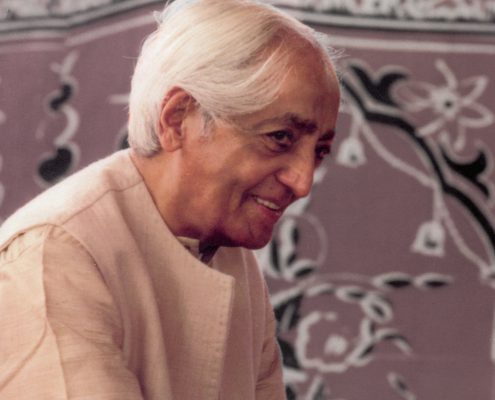J. Krishnamurti’s Life
J. Krishnamurti was born in 1895 in South India. He was discovered at the age of 14 by members of the Theosophical Society, a worldwide spiritual organization. In 1911 he was ordained as the head of the as the “Order of the Star”, a vehicle for his intended future role as world teacher.
However, in 1929 he shocked a 3,000 person gathering at a camp in Ommen, Holland, by dissolving the “Order of the Star” and himself as the head of it, proclaiming that truth can only be found within ourselves and cannot be organized. Throughout his 90 years, Krishnamurti traveled extensively to various countries and places in Europe, America, Asia and Australia. He refused to have followers and often repeated in his lectures ” I am not your Guru, and you are not my disciples.”
Many eminent thinkers, scientists and scholars came to listen and explore the nature of truth with him. These include Aldous Huxley who said “It was like listening to a discourse of the Buddha.” Another very close relationship was with Dr. David Bohm, one of the foremost theoretical physicists who had worked with Einstein and Oppenheimer. Among other notables who had dialogues with him were University of California professor Alan W. Anderson and the Nobel Laureate Jonas Salk.
Krishnamurti established Foundations and schools in Britain, India, USA and Canada. Till the end of his life in 1986, he stressed the need to discover the truth within each of us, in other words “Know Thyself,” without relying on any spiritual authority, including his own.
“We must be very clear on this matter from the very beginning. There is no belief demanded or asked, there are no followers, there are no cults, there is no persuasion of any kind, in any direction, and therefore only then we can meet on the same platform, on the same ground, at the same level. Then we can together observe the extraordinary phenomena of human existence.”
View a video about Krishnamurti…
J. Krishnamurti’s Teachings
The core of Krishnamurti’s teaching is contained in the statement he made in 1980 when he said:
“Truth is a pathless land. Man cannot come to it through any organization, through any creed, through any dogma, priest or ritual, not through any philosophic knowledge or psychological technique. He has to find it through the mirror of relationship, through the understanding of the contents of his own mind, through observation and not through intellectual analysis or introspective dissection. Man has built in himself images as a fence of security – religious, political, personal. These manifest as symbols, ideas, beliefs. The burden of these images dominates man’s thinking, his relationships, and his daily life. These images are the causes of our problems for they divide man from man. His perception of life is shaped by the concepts already established in his mind. The content of his consciousness is his entire existence. This content is common to all humanity. The individuality is the name, the form and superficial culture he acquires from tradition and environment. The uniqueness of man does not lie in the superficial but in complete freedom from the content of his consciousness, which is common to all mankind. So he is not an individual.”
“Freedom is not a reaction; freedom is not a choice. It is man’s pretense that because he has choice he is free. Freedom is pure observation without direction, without fear of punishment and reward. Freedom is without motive; freedom is not at the end of the evolution of man but lies in the first step of his existence. In observation one begins to discover the lack of freedom. Freedom is found in the choiceless awareness of our daily existence and activity.”
“Thought is time. Thought is born of experience and knowledge, which are inseparable from time and the past. Time is the psychological enemy of man. Our action is based on knowledge and therefore time, so man is always a slave to the past. Thought is ever-limited and so we live in constant conflict and struggle. There is no psychological evolution.”
“When man becomes aware of the movement of his own thoughts, he will see the division between the thinker and thought, the observer and the observed, the experiencer and the experience. He will discover that this division is an illusion. Then only is there pure observation which is insight without any shadow of the past or of time. This timeless insight brings about a deep, radical mutation in the mind.”
“Total negation is the essence of the positive. When there is negation of all those things that thought has brought about psychologically, only then is there love, which is compassion and intelligence.”
Please click on www.jkrishnamurti.org for the official depository of his teaching, with a helpful search feature on any topic of interest.


